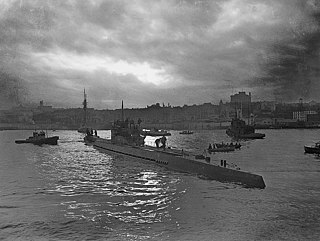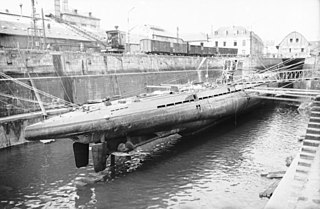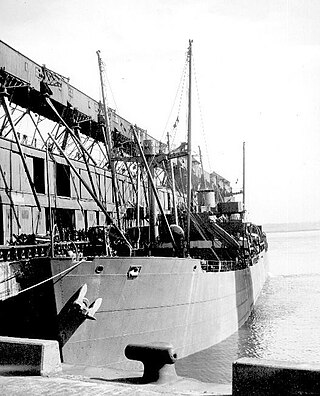
German submarine U-552 was a Type VIIC U-boat built for Nazi Germany's Kriegsmarine for service during World War II. She was laid down on 1 December 1939 at Blohm & Voss in Hamburg as yard number 528, launched on 14 September 1940, and went into service on 4 December 1940. U-552 was nicknamed the Roter Teufel after her mascot of a grinning devil, which was painted on the conning tower. She was one of the more successful of her class, operating for over three years of continual service and sinking or damaging 35 Allied ships with 164,276 GRT and 1,190 tons sunk and 26,910 GRT damaged. She was a member of 21 wolf packs.

This is a timeline for the Battle of the Atlantic (1939–1945) in World War II.
German submarine U-333 was a Type VIIC U-boat of Nazi Germany's Kriegsmarine during World War II. The submarine was laid down on 11 March 1940 at the Nordseewerke yard at Emden, launched on 14 June 1941, and commissioned on 25 August 1941 under the command of Kapitänleutnant Peter-Erich Cremer. After training with the 5th U-boat Flotilla at Kiel, on 1 January 1942 U-333 was transferred to the 3rd U-boat Flotilla based at La Pallice for front-line service.

CP Ships was a large Canadian shipping company established in the 19th century. From the late 1880s until after World War II, the company was Canada's largest operator of Atlantic and Pacific steamships. Many immigrants travelled on CP ships from Europe to Canada. In 1914 the sinking of the Canadian Pacific steamship RMS Empress of Ireland just before World War I became largest maritime disaster in Canadian history. The company provided Canadian Merchant Navy vessels in World Wars I and II. Twelve vessels were lost due to enemy action in World War II, including the RMS Empress of Britain, which was the largest ship ever sunk by a German U-boat.

The Battle of the St. Lawrence involved marine and anti-submarine actions throughout the lower St. Lawrence River and the entire Gulf of Saint Lawrence, Strait of Belle Isle, Anticosti Island and Cabot Strait from May–October 1942, September 1943, and again in October–November 1944. During this time, German U-boats sank over 20 merchant ships and four Canadian warships. There were several near-shore actions involving the drop of German spies, or the attempted pickup of escaping prisoners of war. Despite the 23 ships lost, this battle marked a strategic victory for Canadian forces as ultimately they managed to disrupt U-boat activity, protect Canadian and Allied convoys, and intercept all attempted shore operations. This marked the first time that a foreign power had inflicted casualties in Canadian inland waters since the US incursions in the War of 1812.

The Mediterranean U-boat Campaign lasted from about 21 September 1941 to 19 September 1944 during the Second World War. Malta was an active British base strategically located near supply routes from Europe to North Africa. Axis supply convoys across the Mediterranean Sea suffered severe losses, which in turn threatened the fighting ability of the Axis armies in North Africa. The Allies were able to keep their North African armies supplied. The Kriegsmarine tried to isolate Malta but later it concentrated its U-boat operations on disrupting Allied landing operations in southern Europe.

German submarine U-255 was a Type VIIC U-boat that served in Nazi Germany's Kriegsmarine during World War II. The submarine was laid down on 21 December 1940 at the Bremer Vulkan yard at Bremen-Vegesack, launched on 8 October 1941 and commissioned on 29 November 1941 under the command of Kapitänleutnant Reinhart Reche.

German submarine U-43 was a Type IXA U-boat of Nazi Germany's Kriegsmarine during World War II. The keel for U-43 was laid down in August 1938 at Bremen; she was launched in May 1939 and commissioned in August.

German submarine U-96 was a Type VIIC U-boat of the German Navy (Kriegsmarine) during World War II. It was made famous after the war in Lothar-Günther Buchheim's 1973 bestselling novel Das Boot and the 1981 Oscar-nominated film adaptation of the same name, both based on his experience on the submarine as a war correspondent in 1941.

The Battle of the Caribbean refers to a naval campaign waged during World War II that was part of the Battle of the Atlantic, from 1941 to 1945. German U-boats and Italian submarines attempted to disrupt the Allied supply of oil and other material. They sank shipping in the Caribbean Sea and the Gulf of Mexico and attacked coastal targets in the Antilles. Improved Allied anti-submarine warfare eventually drove the Axis submarines out of the Caribbean region.

The River class was a class of fourteen destroyers of the Royal Canadian Navy (RCN) that served before and during the Second World War. They were named after Canadian rivers.

Convoy SC 118 was the 118th of the numbered series of World War II slow convoys of merchant ships from Sydney, Cape Breton Island, to Liverpool. The ships departed New York City on 24 January 1943 and were met by Mid-Ocean Escort Force Group B-2 consisting of V-class destroyers Vanessa and Vimy, the Treasury-class cutter Bibb, the Town-class destroyer Beverley, Flower-class corvettes Campanula, Mignonette, Abelia and Lobelia, and the convoy rescue ship Toward.

German submarine U-558 was a Type VIIC U-boat in the service of Nazi Germany's Kriegsmarine during World War II. She sank 18 ships totalling 94,099 GRT before being sunk by bombers on 20 July 1943.
An Empire ship is a merchant ship that was given a name beginning with "Empire" in the service of the Government of the United Kingdom during and after World War II. Most were used by the Ministry of War Transport (MoWT), which owned them and contracted their operation to various shipping companies of the British Merchant Navy.

Park ships were merchant steamships constructed for Canada’s Merchant Navy during the Second World War. Park ships and Fort ships were the Canadian equivalent of the American Liberty ships. All three shared a similar design by J.L. Thompson and Sons of Sunderland, England. Fort ships had a triple expansion steam engine and a single screw propeller. Fort ships were ships transferred to the British government and the Park ships were those employed by the Canadian government, both had the similar design. Park ships were named after local and National Parks of Canada. A few Park ships were launched as "Camp ships", named after Canada military camps, but were quickly renamed after Parks. Jasper Park was the first Park ship lost to enemy attack, in the Indian Ocean after a torpedo attack from U-177 in the Indian Ocean, South of Durban, South Africa.

Below is the timeline of maritime events during the Emergency,. This period was referred to as The Long Watch by Irish Mariners. This list is of events which affected the Irish Mercantile Marine, other ships carrying Irish exports or imports, and events near the Irish coast.
German submarine U-410 was a Type VIIC U-boat built for Nazi Germany's Kriegsmarine during World War II, operating mainly in the Mediterranean. Her insignia was a sword & shield, she did not suffer any casualties until she was sunk.
SS Point Pleasant Park was a merchant steamship constructed for Canada's Merchant Navy in 1942 during the Second World War as part of Canada's Park ship program. She carried a variety of wartime cargoes to Atlantic and Indian Ocean ports until the German submarine U-510 sank her off the coast of South Africa on 23 February 1945 as Point Pleasant Park was sailing independently from Saint John, New Brunswick to Cape Town. Point Pleasant Park was the last vessel sunk in South African waters during the Second World War.

The Fort ships were a class of 198 cargo ships built in Canada during World War II for use by the United Kingdom. They all had names prefixed with "Fort" when built. The ships were in service between 1942 and 1985, with two still listed on shipping registers until 1992. A total of 53 were lost during the war due to accidents or enemy action. One of these, Fort Stikine, was destroyed in 1944 by the detonation of 1,400 tons of explosive on board her. This event, known as the Bombay Explosion, killed over 800 people and sank thirteen ships. Fort ships were ships transferred to the British Government and the Park ships were those employed by the Canadian Government, both had the similar design.

SS Jasper Park was a Park ship freighter, built in 1942. She was sunk by torpedo from German submarine U-177 on 6 July 1943, the first Park ship lost to enemy action. She was completed on 24 September 1942, by the company Davie Shipbuilding in Lauzon, Quebec. Her hull number is 537. Davie Shipbuilding is now called Chantier Davie Canada Inc. The ship was owned by the Park Steamship Company, which was owned by Canada's Federal government. The government had built 400 vessels during World War II. Built as a merchant steamship constructed for Canada’s Merchant Navy in 1942. She was named after Jasper National Park in the Canadian Rockies in the province of Alberta, Canada.















